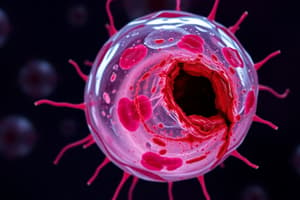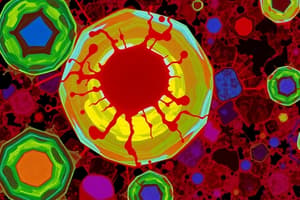Podcast
Questions and Answers
Which of the following is NOT a typical mechanism by which chemical agents induce cell injury?
Which of the following is NOT a typical mechanism by which chemical agents induce cell injury?
- Disruption of cellular metabolic pathways by toxins like cyanide or arsenic.
- Alteration of cell membrane permeability by hypertonic solutions.
- Direct damage to cellular organelles by strong acids or bases.
- Rejection of transplanted organs due to immune system response. (correct)
Psychological stress from conditions such as anxiety and depression can lead to physiological changes that contribute to cell injury.
Psychological stress from conditions such as anxiety and depression can lead to physiological changes that contribute to cell injury.
True (A)
Name three categories of agents or conditions that can lead to cell injury.
Name three categories of agents or conditions that can lead to cell injury.
Physical, chemical, microbial, immunological, nutritional, psychogenic
Anemia can occur as a result of nutritional ______.
Anemia can occur as a result of nutritional ______.
Match the following agents with the type of cell injury they primarily cause:
Match the following agents with the type of cell injury they primarily cause:
Which of the following best describes the difference between reversible and irreversible cell injury?
Which of the following best describes the difference between reversible and irreversible cell injury?
Cellular adaptation always leads to irreversible cell injury.
Cellular adaptation always leads to irreversible cell injury.
Define etiology in the context of cell injury.
Define etiology in the context of cell injury.
The loss of oxygen supply to cells, which can cause cell injury, is referred to as ______.
The loss of oxygen supply to cells, which can cause cell injury, is referred to as ______.
Match the acquired causes of cell injury with their descriptions:
Match the acquired causes of cell injury with their descriptions:
Which of the following is an example of a genetic cause of cell injury?
Which of the following is an example of a genetic cause of cell injury?
Ischemia is the loss of oxygen supply to cells, while hypoxia is the loss of blood supply.
Ischemia is the loss of oxygen supply to cells, while hypoxia is the loss of blood supply.
List two types of irreversible cell injury.
List two types of irreversible cell injury.
Flashcards
Cell Injury: Physical Agents
Cell Injury: Physical Agents
Damage to cells caused by exposure to electric current, UV rays, or radiation.
Cell Injury: Chemical Agents
Cell Injury: Chemical Agents
Cell damage resulting from exposure to toxins like cyanide, strong acids/bases, pollutants, pesticides, or drugs.
Cell Injury: Microbial Agents
Cell Injury: Microbial Agents
Cell disruption caused by bacteria, fungi, viruses, protozoa, or parasites.
Cell Injury: Immunological Agents
Cell Injury: Immunological Agents
Signup and view all the flashcards
Cell Injury: Derangements
Cell Injury: Derangements
Signup and view all the flashcards
Cell Injury
Cell Injury
Signup and view all the flashcards
Cell's Response to Stress
Cell's Response to Stress
Signup and view all the flashcards
Cellular Adaptation
Cellular Adaptation
Signup and view all the flashcards
Reversible Cell Injury
Reversible Cell Injury
Signup and view all the flashcards
Irreversible Cell Injury
Irreversible Cell Injury
Signup and view all the flashcards
Etiology of Cell Injury
Etiology of Cell Injury
Signup and view all the flashcards
Genetic Causes of Cell Injury
Genetic Causes of Cell Injury
Signup and view all the flashcards
Acquired Causes of Cell Injury
Acquired Causes of Cell Injury
Signup and view all the flashcards
Study Notes
Cell Injury: Introduction
- Cell injury is damage or defects within a body's cells.
- It is caused by changes or disturbances in the cell's internal or external environment.
- Cells are the basic units of tissues, organs, and systems.
- Cell injuries result from stress, which leads to changes in the internal and external environment.
- A cell's response to stress varies depending on several factors.
- Cell injury can be reversible or irreversible.
Flowchart Explanation
- Normal cells may adapt when exposed to moderate stress.
- High stress on a normal cell leads to cell injury.
- Cells can become injured after adapting to moderate stress if the originating stress continues to increase.
- Cell injury can be reversed if the stress is removed, allowing the cell to return to a normal state.
- Extreme stress leads to irreversible cell injury.
- Irreversible injury results in cell death.
- Necrosis and apoptosis are two types of irreversible cell injury.
Definitions
- Cellular adaptation is a process where cells survive adverse situations.
- Adaptation involves temporary or permanent changes in a cell’s shape, size, or type.
- Reversible cell injury occurs when mild to moderate stress is removed.
- Cells recover to their normal state after reversible cell injury.
- Irreversible cell injury happens when severe stress leads to cell death.
- Cells cannot recover from irreversible injuries.
Causes of Cell Injury
- Etiology is the study of the causes of cell injury.
- Cell injury is classified into two main categories: genetic and acquired.
Genetic Causes
- Cell injury due to defective genes or chromosomes is classified as genetic.
- Types of genetic defects include developmental defects, cytogenic abnormalities, single-gene disorders, and multifactorial inheritance.
- Developmental defects happen during fetal development.
- Cytogenic defects involve abnormalities in chromosome structure or number.
- Single-gene defects are also known as Mendelian disorders.
- Single-gene defects involve a specific gene defect
- Multifactorial inheritance disorders occur when multiple genes are defective.
- Disorders transfer through genes to offspring.
Acquired Causes
- Acquired causes are non-genetic factors leading to cell injury.
- These include physical, chemical, microbial, immunological, nutritional, and psychogenic agents.
- Hypoxia is a loss of oxygen supply.
- Ischemia is the loss of blood supply.
- Both hypoxia and ischemia are major causes of cell injury.
Physical Agents
- Physical trauma, such as accidents, can damage cells.
- Thermal trauma, such as burns or frostbite, affects cells.
- Exposure to electric current causes cell damage.
- UV rays or radiation in industrial settings can harm cells.
- Rapid changes in the atmosphere can damage cells.
Chemical Agents
- Chemical poisoning from substances like cyanide or arsenic causes injury.
- Strong acids and bases like Hydrochloric acid (HCl) and Sodium hydroxide (NaOH) cause cell damage.
- Environmental pollutants in the atmosphere can damage cells.
- Exposure to pesticides and insecticides can result in cell injury.
- Hypertonic salt solutions disrupt the cell.
- Alcohol, nicotine, and drugs are toxic substances that damage cells.
Microbial Agents
- Microbes such as bacteria, fungi, viruses, protozoa, and parasites disrupt cell functions.
Immunological Agents
- While the immune system protects, hypersensitivity or autoimmune disorders can cause cell injury.
- The body may reject a new organ because the immune system doesn't recognize it.
- Rejection by the immune system can lead to cell injury.
Nutritional Derangements
- Deficiencies or excesses of nutrients can lead to imbalances.
- These imbalances cause cell injury.
- Insufficiency can lead to anemia.
- Excessive intake of nutrients causes obesity.
Psychogenic Disorders
- Psychological factors such as anxiety, depression, and addictions can cause cell injury.
Studying That Suits You
Use AI to generate personalized quizzes and flashcards to suit your learning preferences.




